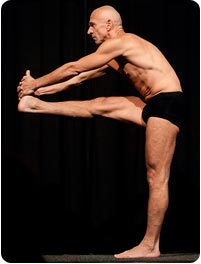Tips for Doing Bikram’s 26 Yoga Poses at Home
Maintain 100-105°F room temperature or body heat because the heat prepares the body for stretching and opens its pores for releasing toxins. Choose a room for yoga practice and heat the room by using a space heater. If you choose a bathroom that has a tub, fill the tub with hot water, which will keep the room hot.
Can’t heat a room? Then wear clothing that will keep your body sweating throughout your yoga  session, but avoid T-shirts and other loose-fitting clothes because they can hinder movement.
session, but avoid T-shirts and other loose-fitting clothes because they can hinder movement.
Can’t heat a room or your body? Then please move more carefully and slowly while breathing more deeply as you move into the yoga poses. The next tip only applies to people who can heat a room.
Wear comfortable but minimal clothes such as shorts or a swimsuit for men and an exercise top (e.g. sports bra or tank top) with shorts or a swimsuit for women. Again, avoid T-shirts and other loose-fitting clothes because they can hinder movement.
Prepare the following:
- 1-2 space heaters
- Thermometer to check on room temperature
- Yoga mat
- Large towel to cover yoga mat so you can avoid slipping
- 1-2 washcloths
- Bottle of water
- Bikram’s Beginning Yoga Class CD or cassette tape if you prefer audio instructions
- Body-length mirror so you can see your poses and adjust them if needed
- A time frame for rest/sleep after your 1st yoga session because some people have reported feeling disoriented and/or tired after their 1st session (this is a sign that the body has begun to cleanse itself)
Eat before practice only if you can finish eating 2-3 hours before doing yoga so your body can digest the food. Recommended foods are raw veggies and raw fruits because they’re easily digestible. If you eat a meal of raw and processed foods, then eating raw foods 1st may help your digestion. Starting your yoga session on an empty stomach is best because if you feel nausea, a full stomach could worsen it.
Drink before practice by hydrating your body comfortably with drinking water starting from several days before your 1st yoga session. 1 hour before your session begins, take smaller sips of water to avoid filling your stomach and to avoid needing to pee while doing yoga.
If you feel lightheaded or dizzy after drinking water, then it may lack the salt and potassium that your body needs. You can mix 1 smidgen (1/2 pinch or 1/32 teaspoon) of sea salt (such as Celtic Sea Salt Fine Ground) into every 8 oz of drinking water; you may need to adjust the amount of sea salt because every body is different. By drinking water mixed with sea salt, your body would produce its own potassium. Alternatively, you can take salt and potassium tablets.
Relieve any feelings of dizziness, nausea, or overheating by sitting on your mat. Keep your eyes open and breathe only through your nose at a comfortable pace. If sitting doesn’t bring enough relief, then you can lie on the mat.
Rest after each pose by doing the corpse pose. Do your final corpse pose for 2-10 minutes to fully benefit from your yoga session.
Let sweat cool your body rather than wipe it away, but please wipe away sweat from your eyes so you can comfortably maintain visual contact with things around you, such as a mirror.
Avoid forming any expectations because doing so could prevent your mind from being receptive to the changes that happen to your body and to your surrounding environment. The more you think about an expectation, the less you’re focusing on safely doing a yoga pose. If you’re used to forming expectations, then alternate between gradually clearing your mind of them and taking a break (just as a dedicated yoga practicer would alternate between gradually learning to do yoga and taking a break from yoga).
Sympathize with your body by doing things that your body comfortably allows you to do; avoid pushing your body past any point of pain. Beginners may need weeks or even years of practice before they can move completely into a Bikram Yoga pose.
Here is a video which could help you as well: